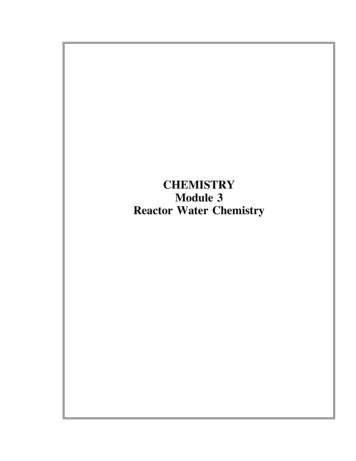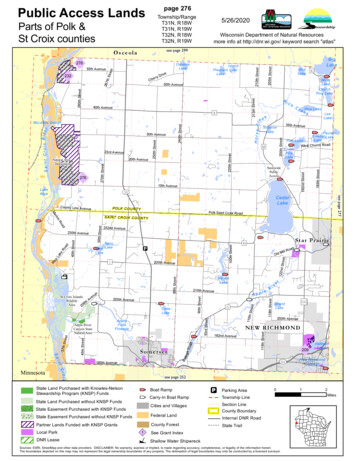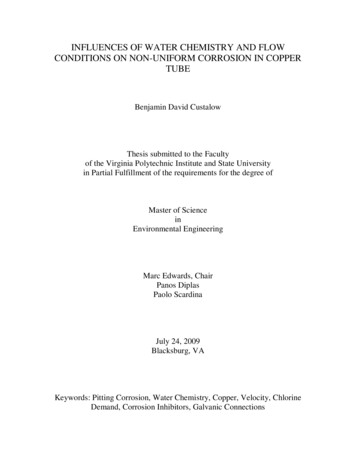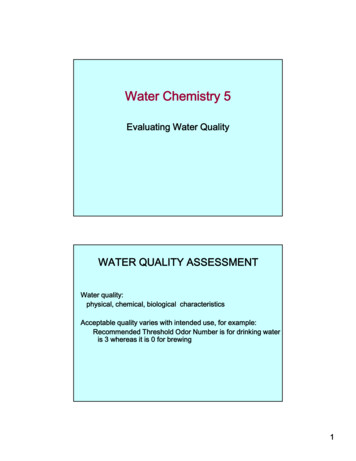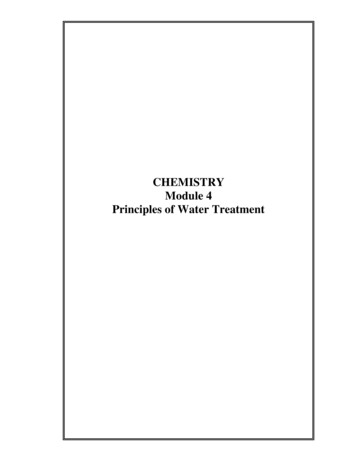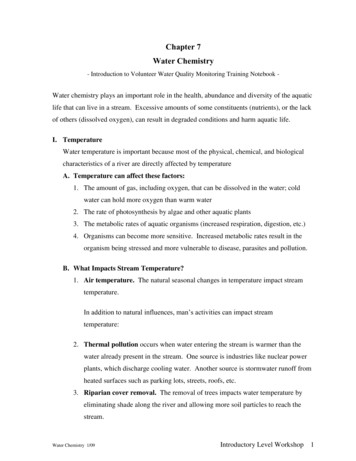
Transcription
Chapter 7Water Chemistry- Introduction to Volunteer Water Quality Monitoring Training Notebook -Water chemistry plays an important role in the health, abundance and diversity of the aquaticlife that can live in a stream. Excessive amounts of some constituents (nutrients), or the lackof others (dissolved oxygen), can result in degraded conditions and harm aquatic life.I. TemperatureWater temperature is important because most of the physical, chemical, and biologicalcharacteristics of a river are directly affected by temperatureA. Temperature can affect these factors:1. The amount of gas, including oxygen, that can be dissolved in the water; coldwater can hold more oxygen than warm water2. The rate of photosynthesis by algae and other aquatic plants3. The metabolic rates of aquatic organisms (increased respiration, digestion, etc.)4. Organisms can become more sensitive. Increased metabolic rates result in theorganism being stressed and more vulnerable to disease, parasites and pollution.B. What Impacts Stream Temperature?1. Air temperature. The natural seasonal changes in temperature impact streamtemperature.In addition to natural influences, man’s activities can impact streamtemperature:2. Thermal pollution occurs when water entering the stream is warmer than thewater already present in the stream. One source is industries like nuclear powerplants, which discharge cooling water. Another source is stormwater runoff fromheated surfaces such as parking lots, streets, roofs, etc.3. Riparian cover removal. The removal of trees impacts water temperature byeliminating shade along the river and allowing more soil particles to reach thestream.Water Chemistry 1/09Introductory Level Workshop1
4. Soil erosion increases the amount of suspended solids carried by the water. Thecloudy water absorbs the sun’s rays, which warms the water.II. Dissolved OxygenA. What is Dissolved Oxygen?Dissolved oxygen (DO) is essential to the survival of organisms in a stream. Thepresence of oxygen is a positive sign and the absence of oxygen is a sign of severepollution. Waters with consistently high dissolved oxygen are considered to be stableaquatic systems capable of supporting many different kinds of aquatic life.B. Sources of Dissolved Oxygen1. Atmosphere. The air we breath contains approximately 21% oxygen whichequates to 210,000 ppm oxygen. Most surface waters contain between 5 and 15ppm DO.2. Photosynthesis by algae and rooted aquatic plants.Plants deliver oxygen towater through photosynthesis.C. Natural Influences on Dissolved Oxygen1. Seasonal Temperature Changes. Gases, like oxygen, are more easily dissolvedin cooler water than in warmer water. DO levels may be higher in winter than insummer.2. Stream Discharge. Dry periods often result in severely reduced stream dischargeand increased water temperatures. This combination acts to reduce DO levels.Wet weather or melting snows increase stream discharge and the possibility formixing of atmospheric oxygen.3. Dissolved or suspended solids. Oxygen dissolves more readily in water thatdoes not contain a high concentration of salts, minerals or other solids.4. Aquatic Plants.a. Density. The density of aquatic plants will affect DO. Fewer plants grow inwinter because of cold temperature and shorter day length. More green plantsmean more photosynthesis, which produces more oxygen during the day whenthe sun is shiningWater Chemistry 1/09Introductory Level Workshop2
b. Respiration. Conversely, plants and animals respire 24 hours per day, usingoxygen and producing carbon dioxide. So there is a net gain in DO as long asphotosynthesis is occurring. In addition, when plants die, DO is used in thedecomposition process. This occurs when organic matter decomposes. Ifthere is an overabundance of algae or other aquatic plants and a large die-offoccurs at one time, DO can be dramatically impacted.D. Diel Oxygen Fluctuation. The term, “diel” refers to a 24-hour period that usuallyincludes a day and adjoining night. During the daylight hours, DO levels rise due toplant photosynthesis. When the sun sets, photosynthesis stops and respirationcontinues. As a result, DO levels naturally drop overnight, reaching their lowest leveljust before dawn, at which time the sun rises and photosynthesis again pumps moreDO into the water. Extensive algal growth can result in large fluctuations in oxygenfrom late afternoon to early morning. If the DO levels fall too low, aquatic animalscan die. This is more of a problem in ponds and in backwaters of streams where flowis nonexistent or very slow.Water Chemistry 1/09Introductory Level Workshop3
E. Human-Caused Changes in Dissolved Oxygen1. Organic wastes. These include wastes from once-living plants and animals andfrom animal feces. Excessive organic waste often comes from sewage treatmentplants, malfunctioning septic systems or manure runoff from animal operations.Organic waste can act as a fertilizer to stimulate aquatic plant growth. In time,these plants die, and they too become organic waste.2. Urban runoff. Rain carries heat, salt, sediment and other pollutants off ofimpervious surfaces (streets, roofs, parking lots) into streams. This raises thewater temperatures and total solids in the water reduceing the amount of DO itcan hold.3. Dams. Some dams are constructed so that water is released from the bottom of alake or reservoir. Seasonally this water can be almost devoid of oxygen. Theopposite problem can occur when water is released from the top of a dam orspillway. This can cause excessive uptake of air from the atmosphere and resultin water that has too much atmospheric gas.4. Removal of vegetation (especially trees) in the riparian corridor. A lack ofshade causes increased water temperature and a lack of protection from erosion.This causes increased suspended solids that can work together to reduce oxygenlevels.Depletion of DO can cause a major shift in the types of aquatic organisms presentin a stream from pollution sensitive species to pollution tolerant species.III. Nitrates and AmmoniaA. What is Nitrogen?Nitrogen is required by all living plants and animals for building protein. In aquaticecosystems, nitrogen is present in different forms. The usable forms of nitrogen foraquatic plant growth are ammonia (NH3) and nitrate (NO3). Excess amounts ofnitrogen compounds can result in unusually large populations of aquatic plants and/ororganisms that feed on plants. For instance, algal blooms can be a result of excessnitrogen. As aquatic plants and animals die, bacteria break down the organic matter.Water Chemistry 1/09Introductory Level Workshop4
B. Ammonia (NH3 or NH4) is oxidized, or combined with oxygen, to form nitrites (NO2)and nitrates (NO3)NH O32 NO O22 NO3The cycle for breaking down organic matter (both the biological process and thechemical process) uses up dissolved oxygen.Sources of Excess Nitrates and Ammonia in Streams:1. Poorly functioning septic systems2. Inadequately treated wastewater from sewage treatment plants3. Storm drains4. Runoff from feed lots5. Runoff from crop fields, parks and lawnsIV. PhosphorusA. What is Phosphorus?Phosphorus usually takes the form of phosphate (PO4) in water. Phosphorus is also aplant nutrient, and is often the limiting nutrient for plant growth, as it is less prevalentin surface water than nitrogen. Small increases in phosphorus, however, can result ina large impact on the growth of aquatic plants. Phosphorus binds readily with soilparticles. Soil must be highly saturated with phosphorus before excess amounts aredetectable in shallow groundwater that can enter streams and cause negative impacts.B. Sources of Excess Phosphorus in Streams:1. Septic systems and wastewater from sewage treatment plants2. Runoff from feed lots and from the application of animal wastes on fields3. Runoff of commercial fertilizer from crop fields, lawns, golf courses or parksV. TurbidityA. What is Turbidity?Turbidity testing measures the clarity of water. Low turbidity water is clear whilehigh turbidity water is cloudy or murky. Cloudy water is most often caused bysuspended matter (such as soil particles) and plankton (such as algae). By evaluatingWater Chemistry 1/09Introductory Level Workshop5
how turbid the water is, you can evaluate whether excess soil erosion or algal growthis occurring.B. Sources of Excess Turbidity in Streams:1. Development, construction and land disturbance can result in soil erosion.2. Quarries and gravel mining operations can result in fine sediment entering astream and smothering habitat.3. Agricultural areas that have not adopted “best management practices” to preventsoil erosion leak sediment to local waterways.VI. pH (parts Hydrogen)A. What is pH?Water (H2O) contains both H (hydrogen) ions and OH- (hydroxyl) ions. “pH” is anabbreviation for the French expression, “Pouvoir Hydrogene,” meaning “the power ofHydrogen.” It measures the H ion concentration of substances and gives the resultson a scale from 0 to 14. Water that contains equal numbers of H and OH- ions isconsidered neutral (pH 7). If a solution has more H than OH- ions, it is consideredacidic and has a pH less than 7. If the solution contains more OH- ions than H ions,it is considered basic and has a pH greater than 7.The pH scale is logarithmic. This means that you go up and down the scale, thevalues change in factors of ten. A pH change of one point indicates that the strengthof the acid or base has increased or decreased tenfold; a two-point pH changeindicates a 100-fold change in acidity or basicity; a three point change indicates a1000-fold change in acidity or basicity. For example, when the pH changes from 7 to8, there are now 10 times more OH- ions present than H ions. If it changes from 10to 8, there are 100 times more H ions than OH- ions. Small changes in pH result inlarge changes in water chemistry.B. Human-Caused Changes in pH:In the United States, the pH of rivers is usually between 6.5 and 8.5. Rain water ismore acidic and normally has a pH between 5.0 and 5.6. Increased amounts ofnitrogen oxides (NO3) and sulfur dioxide (SO2), primarily from automobile and coal-Water Chemistry 1/09Introductory Level Workshop6
fired power plant emissions, are converted to nitric acid and sulfuric acid in theatmosphere, resulting in acid rain or snow. The geology of an area determines the pHof the local water. If limestone is present, like much of Missouri, the alkaline (basic)limestone neutralizes the effect acid rain might have on lakes and streams.C. Changes in Aquatic LifeMost organisms have adapted to life in water of a specific pH and may die if the pHchanges. At extremely low or high pH values (4.5 or 11.0 respectively) the waterbecomes lethal to most organisms. pH is also important because of how it affectsother pollutants in the water. Very acidic waters can cause heavy metals to bereleased into the water column. The metals can then be taken up and accumulated inthe food chain. Metals in the water, such as copper and aluminum, can accumulate onthe gills of fish or cause deformities in young fish, reducing their chances of survival.In basic water, ammonia compounds convert to a toxic form; the more basic thewater, the more toxic the ammonia that is present.Water Chemistry 1/09Introductory Level Workshop7
Water temperature is important because most of the physical, chemical, and biological characteristics of a river are directly affected by temperature A. Temperature can affect these factors: 1. The amount of gas, including oxygen, that can be dissolved in the water; cold water can hold more oxygen than warm water 2. The rate of photosynthesis by algae and other aquatic plantsFile Size: 245KBPage Count: 7
